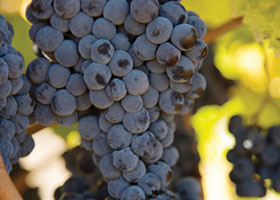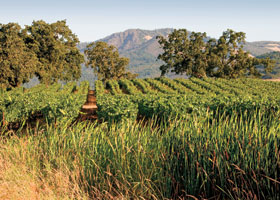Warming Up the Wine Industry

Climate change may not only impact coral reefs, glaciers and polar bears, but could also have a significant effect on the U.S. wine industry. A recent study led by researchers at Stanford University estimates that in the next 30 years areas like Napa Valley, California, may be too hot to sustain the grape varieties currently grown there for premium wines.Most U.S. wine comes from the West Coast, with California alone accounting for over 90% of the nation’s total wine production. The Wine Institute (wineinstitute.org), a trade organization representing California’s winemakers, estimated the industry to be worth $18.5 billion in retail value in 2010. Researchers focused on the 25% most expensive wines in the market, and the projected growing conditions in four counties with varying temperature ranges: Napa and Santa Barbara counties in California, Yamhill County in Oregon’s Willamette Valley, and Walla Walla County in Washington’s Columbia Valley. The study reports that by 2040 the amount of land suitable for cultivating premium wine grapes in northern California could shrink by 50% due to climate change. Some cooler states, like parts of Oregon and Washington, could see an increase in premium grape-growing acreage with a warming climate.
Gregory Jones, Ph.D., a professor in the Department of Environmental Studies at Southern Oregon University, explains what kind of effect temperature has on grapes: “Most specialty crops have fairly narrow climate and geographic niches,” he says. “But what makes wine grapes more sensitive are the differences between varieties. For example, the entire range of climate for wine grapes is approximately 10° Celsius globally; however, individual varieties can have narrower ranges down to 2° Celsius for pinot noir.” Even a one degree temperature change outside of that range can make the different between a poor, good or excellent vintage. “Colder-than-normal temperatures lead to incomplete ripening with high acid, low sugar and unripe flavors,” Jones says. “Warmer-than-normal temperatures create overripe fruit with low acid, high sugar, high alcohol and cooked flavors.”

Napa Valley is known for its pinot noir, cabernet sauvignon and other premium wines. According to the Stanford study, the average temperature in Napa during growing season could increase as much as 1.1° Celsius, with the number of very hot days increasing to 10. This would mean serious trouble for the finicky pinot noir vines.
Richard Smith, the owner of Paraiso Vineyards in Monterey County, California, focuses his 400-acre vineyard on cultivating estate Pinot Noir, as well as smaller lots of Chardonnay, dry Riesling, Syrah and Souzao Port. Smith says, in general, that temperatures vary more from year-to-year than decade-to-decade. “I expect that if the next 30 years are similar to the past 30 years that the [temperature] changes will not dramatically change the choices of varieties that I grow at each given site,” he says. Paraiso Vineyards grows 14 varieties on six different rootstocks, with 20 to 30 different combinations.There are more than 5,000 grape varieties worldwide, and U.S. vineyards have begun experimenting with more international varieties, especially ones with greater tolerance for warmer temperatures. Breeding programs typically select for traits such as disease and pest resistance, drought resistance, root architecture and other physical characteristics. With climate change impacts in mind, breeders are looking for varieties that are salt tolerant and drought tolerant, with other traits such as vigor and root depth. Jones says that genetic engineering programs are trying to “isolate the genes that allow some varieties to do well under these conditions and see if they can be bred or genetically manipulated into other varieties.”There will be some push-back from vineyards on using genetically modified grapes. The Wine Institute, along with all of the California vineyards the Institute represents, oppose the use of any genetically modified organisms in their wines. California vineyards like Paraiso are focused on traditional breeding programs to create new varieties. Growers may be able to maintain the quality of their grapes by using existing cultivation and winemaking techniques, using shade vines to shade the grapes, irrigating to cool the plants or adjusting fermentation processes among other strategies. The Stanford University study found that acreage in Napa and Santa Barbara counties will increase if growers are able to produce quality grapes that can tolerate up to 45 very hot days and average temperatures of 22° Celsius during growing season. The authors also noted, however, that varieties grown under these conditions produce wine of considerably lower quality and value.

